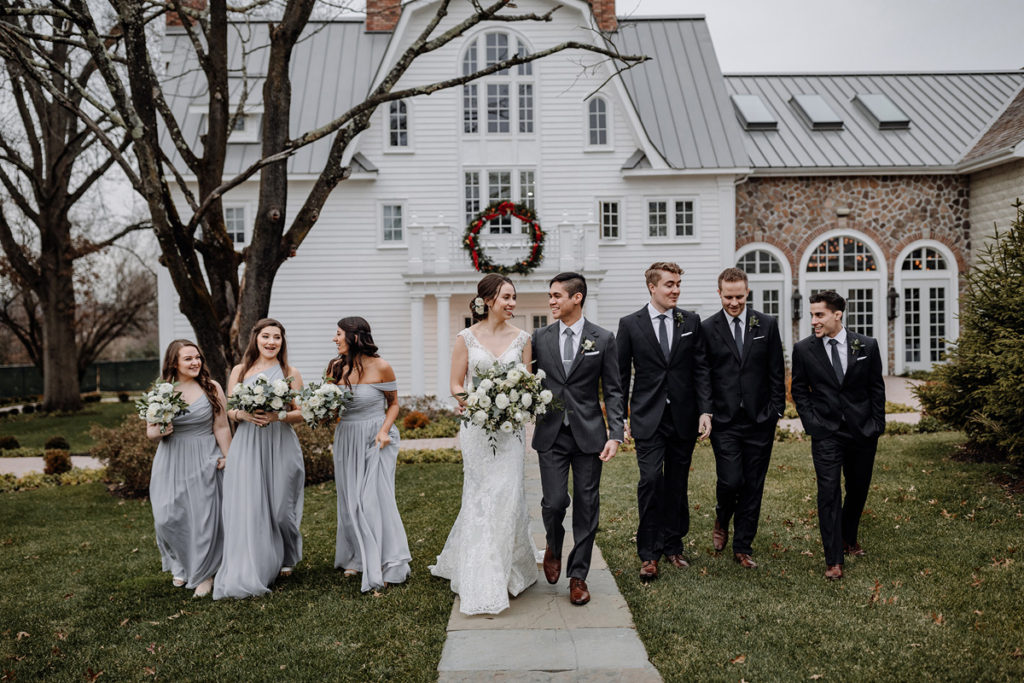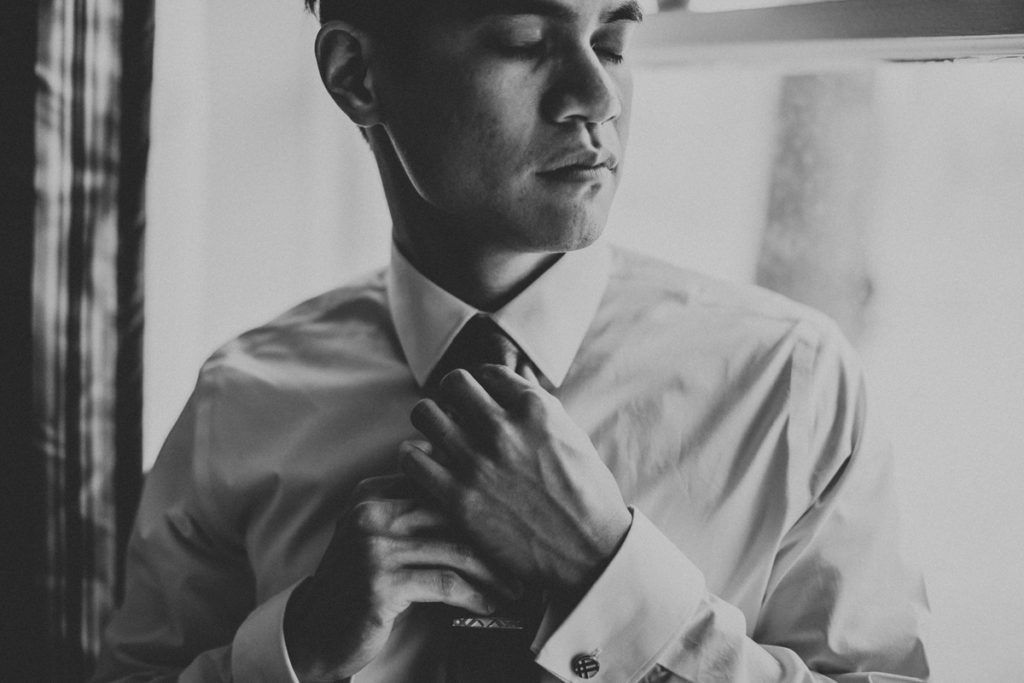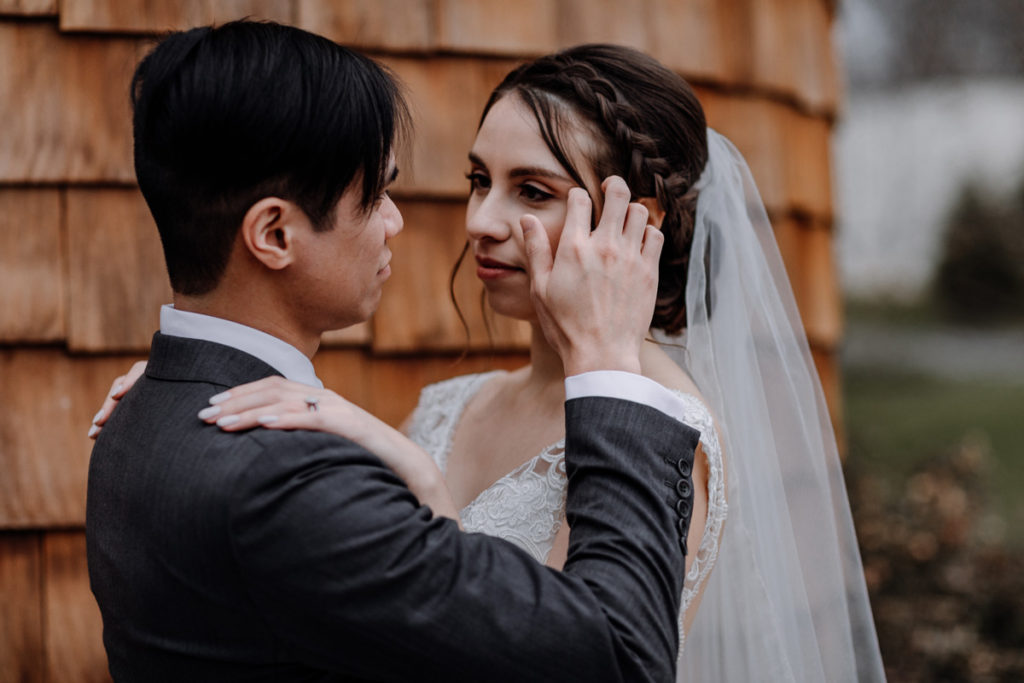Last Updated: February 14th, 2020
Solo wedding photographers have one of the toughest jobs.
We like to refer to having a partner or second-shooter along for the ride at a wedding to be a bit like an “insurance policy.” It’s mostly tongue-in-cheek, but there is some truth to it. With two competent photographers, you can almost be guaranteed to walk away with a lot of great shots – and definitely have the “must have” pictures covered.
When you’re shooting on your own, capturing a wedding day effectively is still entirely possible, but it can be more challenging. Of course, things get easier with proper preparation, and that’s what we’re going to help you do here!
1). Communicate with your clients before the wedding
 If you think that wedding photography begins when you arrive to the venue on the big day, you’re wrong!
If you think that wedding photography begins when you arrive to the venue on the big day, you’re wrong!
There is more to wedding photography than just taking pictures.
Often, the best wedding photographers do a lot to ensure things will go as smoothly as possible, so they can get the shots they want, and their clients NEED.
Having effective communication beforehand will help the wedding day go smoother. In your emails, phone call chats, and in person meetings – you’ll want to make sure you cover a few simple (but important) things:
- What are the most important shots of the wedding day for the couple?
- Where will the guys and gals be getting ready? Same location or different places?
- What special events will be taking place during the wedding day?
In addition to these questions, you’ll also want to set expectations for what is possible. Do this early and often if needed.
For example, if the guys and girls are getting prepared at different locations, you can’t be in two places at once. This means the timing of things need to work out, so you can travel between locations, or it may be the case that only the ladies want getting ready photos (this does happen sometimes!).
The bottom line – discussing things before the wedding day is much easier than trying to have these conversations on the wedding day!
2). Send a wedding day photography questionnaire
Going along with the communication you are having with your clients, we also recommend putting together a wedding day questionnaire.
In this, you may cover some things you’ve already discussed before, but it’s the prime opportunity to collect everything you could possibly need so you have all the information in one place.
If you’re unsure where to get started or if you’re even asking for the right things, we recommend getting Signature Edit’s Wedding Timeline Questionnaire. In it, everything you need to get the right questions answered are already put together for you!
3). Create a wedding day photography timeline
 Once you have a completed questionnaire back from your clients, you can take that information and put together a wedding day photography timeline.
Once you have a completed questionnaire back from your clients, you can take that information and put together a wedding day photography timeline.
In our experience, timelines are what separate beginner photographers from seasoned professionals.
You can be a great photographer yet do wedding photography poorly because planning really benefits the process in so many ways.
In our timelines, we break down the day so we know when all of the important things are going to happen. We plan out everything like:
- Starting and end times
- Getting ready photo timing
- When the bride will get into her dress
- What time the first look will take place
- Family formals, bridal party portraits, and bride & groom portraits
- Ceremony start and end times
- Timing of all the reception events (start time, toasts, first dances, bouquet toss, etc.)
One of the great benefits of putting together a timeline like this is that it will help eliminate stress for both you (the photographer) and for the couple. Wedding days can be stressful, and often people are planning them a year (even 2!) in advanced – so it can feel like this impossible event. Writing everything down will help all involved to better visualize how the day is going to run.
4). Talk with the wedding coordinator
If your client’s have hired a wedding coordinator or have one included with their venue package, connect with that person. You can do this either in advanced of the wedding or on the wedding day itself – it will vary depending on the coordinator.
When available and doing their job well, wedding coordinators will make a world of difference for you.
But…what if the couple didn’t hire a wedding coordinator?
In weddings we shoot, we see this more often than not. Wedding coordinators are an added expense – the best of them charging thousands of dollars to support the wedding. Unless your client’s have a high budget, a wedding coordinator might not be in the cards.
If you don’t have this extra support during the wedding day, have no fear!
There is a simple alternative solution…
In advance of the big day, have your clients designate someone to assist with coordinating on the day. Most likely, this will be a parent, sibling, or a friend in one of the bridal parties. While they won’t (and shouldn’t) be doing ALL of the daily coordinating, they can help in the more stressful parts of the day.
We use this approach to have an immediate “go-to” person to help us with wrangling up family for portraits. This is often difficult for us to do on our own as, of course, we don’t know what everyone looks like!
5). Refer to a shot list
Having a shot list put together will help you to make sure you are capturing the “must have” photos during the wedding day. There was a time when we didn’t feel they were necessary, but given how stressful and action packed weddings can be for everyone, they serve a simple purpose: to make sure we’re capturing the shots we need.
Your shot list should be made up of two things:
- Photos your client wants taken
- Photos you want to take
Your clients may have special photos they’d like captured during the day. Even if they end up leaving photography up to your vision, they will still want to provide a list of family formal groupings.
As for yourself, if there are specific types of photos you like to consistently capture, write them down.
6). Check out the venue in advance
 If you have the opportunity, getting to a wedding venue prior to the wedding day can be a simple way to make sure you know all the great spots for photography.
If you have the opportunity, getting to a wedding venue prior to the wedding day can be a simple way to make sure you know all the great spots for photography.
In practice, this is not always possible.
Sometimes you will be photographing at a venue hours away – in this case, it’s just not feasible to drop in beforehand.
What we do recommend is, at least, this:
Check out the venue online. You can do research by looking at other weddings that have been photographed there. Some venues you can pull up on Google Maps and get a lay of the land virtually.
On the day of the wedding, consider arriving a little bit before your start time. We often will arrive just 30 minutes early to scope things out. It goes a long way!
7). Arrive early and pre-plan when possible
In addition to getting to the venue just a little bit earlier, you can do a good deal of pre-planning on the spot.
For us, this is really essential.
We might have a simple game plan going into the day, but factors like the weather and light on the wedding day have a huge impact in the photos we are taking.
Normally, an overcast day will be easier for photography than a bright and sunny one.
If you are facing a harsh light day, try planning things like the first look, portraits, etc. to be in locations where you can have better control of the light.
8). Have the right photography gear for the job
 We try not to place too much focus on the camera gear you are using as a great photographer can use even a cheap camera and take great photos. This is something we believe to a large extent, but the truth is: budget gear will only go so far. It will not perform as well in low light conditions. And there is a noticeable difference in quality when you’ve used and can compare a 200$ camera setup with a $4,000 dollar one.
We try not to place too much focus on the camera gear you are using as a great photographer can use even a cheap camera and take great photos. This is something we believe to a large extent, but the truth is: budget gear will only go so far. It will not perform as well in low light conditions. And there is a noticeable difference in quality when you’ve used and can compare a 200$ camera setup with a $4,000 dollar one.
If you’re comfortable with the gear you’re currently using, great!
If you’re not OR want to check out some other options, we put together a Wedding Photography Gear Checklist for you to check out. For even more, you can check out our Recommend Gear page, too!
9). Carry two cameras at once for easy swapping
As a solo photographer, this wedding photography tip is especially important!
It’s important to have at least 2 cameras on hand when shooting a wedding. You will use one as your primary camera, and the other as a backup.
During key moments, like the wedding ceremony, it can be difficult, loud, and time consuming to swap lenses. To help solve this challenge, you can carry both of your cameras at once. But how do you do this?!?
It’s easy!’
Having a camera harness can make a world of difference.
We have used both cheap harnesses, and also have the Holdfast Moneymaker as a better quality and more stylish version. They come HIGHLY recommended for wedding photography.
[amazon_link asins=’B00BTL113O,B00RKVGXYY,B00P2OSOFC,B01GGOJS92′ template=’ProductCarousel’ store=’ffl0d-20′ marketplace=’US’ link_id=’919d092b-e5ae-40a1-a238-fc0450b2df66′]
10). Move around a lot
 Any wedding photographers should be on the move frequently throughout the day, but if you’re photographing a wedding on your own – it’s extra important!
Any wedding photographers should be on the move frequently throughout the day, but if you’re photographing a wedding on your own – it’s extra important!
One of the great things to know is, you don’t necessarily need to be sprinting from place to place.
What we look for is photo diversity.
For example, when shooting portraits, simply stepping to the side (while the person stays in the same position) will open up a new perspective.
Using a zoom lens at times can also be a simple way to get more photo diversity without forcing you to move around too much.
11). Be confident
This last tip is easier said than done.
We know it can often be difficult to feel confident, especially when you are still just learning and honing your skills.
For the first few years of our wedding photography business, we literally felt like we were living the statement: “Fake it ’till you make it!”
There is a lot of truth to be found in that quote. You’re not always going to know what exactly to do. Weddings are constantly evolving environments with a lot of things going on. All you can do is be confident in what you do know and prepared to adapt as much as possible.
With time, as you shoot more and more weddings, we can tell you this:
Wedding photography will get easier.
You will learn the ropes, and it will be easier to adjust to the things happening around you as you start to identify the normal things that happen again-and-again.
As introverted people, we’ve had to grow a lot to take on the social side of wedding photography – making sure we’re communicating effectively, giving a helping hand, and knowing when to say “no” to requests that hinder us from doing our job. But, we wouldn’t trade it for anything. Wedding photography is a whole lot of fun!